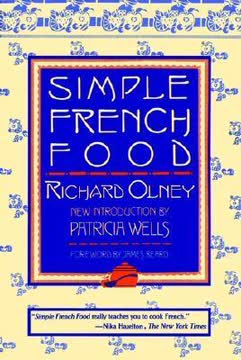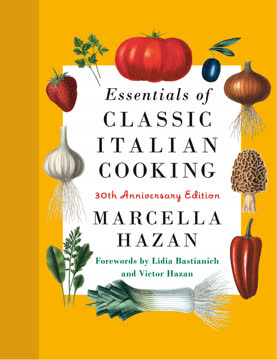Key Takeaways
1. Simplicity as an Effect: The Essence of Good Food
Before even attempting to formulate a satisfactory definition, I think that one must, inverting the key phrase, say, “If food is not good, it is not simple.”
Beyond mere ease. True simplicity in cooking isn't about minimal effort or lack of adornment; it's the harmonious effect achieved when all elements coalesce perfectly. This means food that tastes inherently good, where flavors are pure and balanced, rather than masked or confused by excessive complexity. It's an artistic ideal, where the final statement is vibrant and unadorned, justifying any intricate preparations.
Sensuous engagement. Food and wine are not just sustenance but essential threads in the fabric of a whole, sensuous life. The formalization of gastro-sensory pleasure, human communion at table, and the sharing of voluptuous experiences are primordial. This holistic appreciation elevates cooking beyond mere utility, making it a spiritual and joyful pursuit.
Artistic purity. Simplicity in cooking mirrors simplicity in art: it's the purity and spontaneity of the effect that matters. Just as a painter strives for an unadorned, vibrant statement, a cook aims for dishes where the integrity of the basic product is enhanced, striking a single, suave note rather than a cacophony of competing flavors.
2. Ingredients First: Unwavering Respect for Quality and Seasonality
Good food, great food, depends upon an unwavering respect for the freshness and quality of ingredients, whether they be a simple red potato, a golden knob of butter, a fragrant sprig of thyme, a plump clove of garlic.
Quality is paramount. The foundation of any truly great dish lies in the inherent quality and freshness of its ingredients. Olney champions local, seasonal produce, emphasizing that even the simplest items—like a sun-hot August tomato or a freshly laid farm hen's egg—possess an ultimate perfection that no amount of culinary wizardry can replicate if the raw material is inferior.
Beyond commercial norms. The author laments the decline in quality due to commercialization, from tasteless supermarket tomatoes to over-processed vegetable oils. He advocates for seeking out:
- First cold-pressing olive oil with a rich, clean, fruity flavor.
- Unsalted tub butters with distinct taste.
- Firm-textured, heavy-crumb breads, often found in Italian neighborhood bakeries.
- Freshly picked, seasonal vegetables and seafood from vibrant outdoor markets.
Preserving integrity. Respect for ingredients also means understanding how to treat them minimally to preserve their native qualities. This includes proper peeling of asparagus, careful handling of fish, and avoiding overcooking, which can dull flavors and ruin textures.
3. Tradition and Technique: The Foundation for Creative Improvisation
Only a cookbook is needed to prepare a boeuf Bourguignon but, without rules, improvisation is impossible—and that is what cooking is all about.
Understanding the "why." Cooking rules are not rigid dictates but a rich well of centuries-old experience. True mastery comes from understanding the logic behind each step—why an ingredient is added at a certain point, how heat transforms materials, or which flavors harmonize. This deep comprehension liberates the cook from blind adherence to recipes.
Improvisation as art. Creativity in the kitchen, much like in a studio, is the application of personal expression to an intimate understanding of established rules. Without this framework, improvisation becomes chaotic and often leads to poignant failures. Olney encourages playful, self-renewing invention, where dishes are dictated by available materials and guided by experience and judgment.
Learning from mistakes. The author views failures as instructive, often more so than successes. He encourages experimentation, even with leftovers, to transform disparate fragments into coherent and exciting meals. This process of trial and error, combined with a solid grasp of culinary principles, is key to developing a cook's intuition and palate.
4. The Unquestioned Presence: Mastering Herbs and Their Nuances
For my part, the classroom has been instructive in many ways. One forgets so easily and I had long since come to think of herbs as an unquestioned presence in the kitchen.
Beyond mere seasoning. Herbs are not just an afterthought but an essential, often overlooked, element that can define or elevate a dish. Olney stresses the importance of using fresh, high-quality herbs, distinguishing them sharply from "powdered condiments, vaguely peppery and dusty to the nose." He encourages home cultivation, even in small pots or window boxes.
Specific affinities. Each herb possesses a unique personality and specific affinities:
- Basil: Natural affinity for tomatoes, sweet peppers, olive oil, garlic; best torn, not chopped, and added terminally.
- Dill: Predestined for cucumber and fish, especially crayfish.
- Fennel: Essential for bouillabaisse, grilled fish (loup de mer), and often paired with pastis.
- Marjoram: Heavenly fragrance, marries caressingly with eggs and many vegetables.
- Oregano: Must be dried to give its perfume; valuable for grilled lamb, game birds, and guinea fowl.
- Rosemary: Troublesome and aggressive when green, but its smoke on coals is subtle and genial.
- Sorrel: Refreshing acidity, a graceful change from lemon, enhances meat, fish, poultry, eggs, and vegetables.
Proper usage. Herbs suffer from both underuse (in bland bouquets garnis) and overuse (with grills and roasts). Olney advises discretion, noting that some herbs, like tarragon, can become repellent if too liberally dispensed. He also highlights the value of dried herbs, provided they are relatively fresh and dried on the branch.
5. Wine in the Kitchen: A Noble Ingredient, Not a Sacrifice
There should be no question of using a wine in the kitchen that one does not consider good enough to serve at one’s table.
No "cooking wine." Olney vehemently rejects the notion of "cooking wine," asserting that any wine not fit for drinking has no place in the kitchen. Wine in cooking is a natural moistening agent, transforming its original nature through heat, but only good wine can contribute positive qualities.
Heat's transformation. Heat alters or completely transforms a wine's character. Therefore, sacrificing a "great" wine (one that evolves with subtle nuances) in cooking is a waste, as its mystery is erased. A "good" wine—robust, honest, with frank fruit and solid structure—is perfectly suited, as its qualities are put to good use without loss of transcendence.
Beyond color. The conventional wisdom of pairing red wine with red meats and white wine with white meats or fish is often a "cerebro-visual aesthetic" rather than a "sapid reality." Olney argues that any dish traditionally made with white wine can be prepared with red, and vice versa, yielding different but equally good results. The only practical considerations are:
- Avoiding dull violet-brown color in creamed sauces with red wine.
- Achieving a rich, nearly black civet, which requires red wine.
6. The Art of the Terrine: Transforming Humble into Sublime
A simple terrine, based on a single forcemeat and a single meat garnish, is never so good as when prepared in the easiest possible way, all of the ingredients of the composition mixed, pell-mell but intimately, together.
Beyond the pâté. Olney distinguishes terrines from pâtés, which he finds excessively laborious and often no better. Terrines, especially simple ones, achieve their best when ingredients are intimately mixed, rather than elaborately layered. This approach emphasizes flavor fusion over complex presentation.
Hand-chopping's virtue. Mechanical grinding or chopping crushes meat fibers, releasing juices and resulting in a pastier, drier texture. Hand-chopping, using sharp knives, preserves the fibrous structure, retaining succulent juices and lending a varied, superior texture to the forcemeat. This meticulous detail significantly enhances the terrine's character.
Essential components. A good terrine relies on a balanced composition:
- Tender meats: Left whole or in large pieces for textural variety.
- Tougher flesh: Chopped and combined with bland meats (veal, pork) for the forcemeat base.
- Liver: Adds smoothness and binds with egg.
- Pork fat: Crucial for moisture and richness, often three times the amount typically used.
- Breadcrumbs: Discreetly added for lightness.
- Reduced stock: Provides gelatinous binding and deepens flavor.
- Fat pork lining: Forms a serving-friendly wrapper, superior to bacon.
7. The Gentle Art of Stewing: Unhurried Perfection in Every Bubble
Le coin du feu is the hearth that, even for those who have never known it, recalls the security of the family united before it in warmth. But the magic word in the magical phrase is mijoter.
Mijoter's magic. The essence of a great stew lies in "mijoter"—a slow, barely perceptible simmer where tiny bubbles rise to the surface. This unhurried process allows for a gradual ripening and perfect fusion of flavors, ensuring tender meat and a rich, clear sauce. Boiling, by contrast, yields dry, stringy meat and a muddy, indigestible sauce.
Daubes vs. sautés. Olney differentiates between daubes and sautés:
- Daubes: One-step affairs where meats and aromatics cook together, moistened, until done. The sauce's body comes from natural gelatin, emphasizing pervasive unity of flavor.
- Sautés: Involve initial browning of meats and vegetables, light flour thickening, and moistening. The sauce is often strained, skimmed, and reduced separately before rejoining the meat and garnish, aiming for an interplay of distinct flavors united by a common sauce.
Aromatic foundations. Onions, carrots, and garlic are constant aromatic allies. Herbs, especially thyme, bay, and often oregano or savory, are crucial. While bouquets garnis are practical for easy removal, finely crumbled herbs scattered through a rough sauce are equally effective.
8. Dry Heat Cooking: Preserving the Pristine Beauty of Roasts and Grills
The eloquence of a roast slowly turning before living flames, its visible transfiguration as it contracts, swells, and, fondled by repeated basting, assumes a luxuriant brown satin glaze, has an entrancing effect on a company.
Open fire's superiority. Roasting before an open fire surpasses oven roasting due to the dry, open air and the delicate flavor imparted by wood smoke. This method creates a visible transfiguration, resulting in a succulent, beautifully glazed roast. The ritual beauty and suspense of open-fire cooking enhance the sensory experience.
Precision in grilling. Grilling requires attention to the type of wood (fruit woods are best), coal intensity, and distance from the heat. Hinged, double-faced grills are essential for delicate fish and meats, preventing sticking and tearing. Meats should be at room temperature before cooking and salted strategically to prevent juice loss.
The art of basting and resting. Roasts and grilled meats benefit from regular basting with olive oil or marinade, which contributes to a rich, glossy surface. After cooking, meats should rest in a warm place for a period relative to their size. This allows internal heat to penetrate evenly, tenderizing the flesh and freeing juices, resulting in a more succulent and tender product.
9. The Humble Egg: Versatility in Omelets, Scrambles, and Gratins
Correctly prepared, the softest of barely perceptible curds held in a thickly liquid, smooth, creamy suspension, scrambled eggs number among the very great delicacies of the table.
Omelet's simplicity. The rolled omelet, often mystified, is a simple, rapid preparation that requires no special talent. Its quality hinges on fresh eggs and good butter. Olney emphasizes light beating, rapid cooking in a hot, buttered pan, and quick rolling to achieve a tender, barely set interior. Flat omelets, often incorporating vegetables, require careful handling to avoid breaking.
Scrambled egg perfection. Scrambled eggs, when prepared correctly, are a delicate art. They should be cooked gently over low heat or in a bain-marie, stirred constantly with a wooden spoon until they form soft, barely perceptible curds in a creamy suspension. Removing them from heat just before desired consistency and stirring in a touch of cream halts cooking and enhances silkiness.
Hard-boiled and gratins. Hard-boiled eggs, ideally 4-5 days old for easy peeling, should be started in cold water and simmered gently to avoid rubbery whites and discolored yolks. They are versatile in salads and gratins, where their gentle presence can mollify sharper flavors. Gratins, often with béchamel, cheese, or buttered breadcrumbs, transform eggs and vegetables into comforting, golden-crusted dishes.
10. The Soul of Provençal: Garlic, Olive Oil, and Regional Identity
The internationalizing influence is not unique to Provence—or to France. My alarm is merely greater.
A distinct identity. Olney's heart lies in Provence, where the flavors are direct, uncomplicated, and reflect the sharp clarity of the light and landscape. He expresses alarm at the internationalizing influence threatening regional culinary traditions, advocating for the preservation of this unique culinary soul.
Key Provençal elements:
- Olive oil: The best sauce, rich, clean, clear, and fruity, forming the base of many dishes.
- Garlic: A fundamental presence, often pounded to a purée for discreet flavor or used generously in dishes like aïoli.
- Herbs: Basil, fennel, oregano, savory, and thyme are integral, often growing wild on hillsides.
- Tomatoes: Used fresh in season, or canned when out of season, forming the backbone of many sauces and stews.
- Regional dishes: Soupe au pistou, daube à l’Avignonnaise, caillettes, and various gratins embody the spirit of the region.
The spirit of the market. The vibrant, crowded outdoor markets of Provence, brimming with freshly picked produce, seafood, and local specialties, are a testament to the enduring desire for quality ingredients. These markets are not just places of commerce but cultural experiences, reflecting a deep-seated love for food and a commitment to culinary traditions.
Last updated:
Review Summary
Simple French Food receives mixed reviews, with an overall positive reception. Many readers appreciate Olney's opinionated and entertaining writing style, finding the book enjoyable to read even if they don't cook from it. Some praise the detailed techniques and authentic French recipes, while others find them complex and outdated. Critics note that "simple" in the title is misleading, as many recipes are elaborate. Despite this, the book is often lauded for its passionate approach to cooking and its ability to transport readers into Olney's kitchen.
Similar Books
Download PDF
Download EPUB
.epub digital book format is ideal for reading ebooks on phones, tablets, and e-readers.









